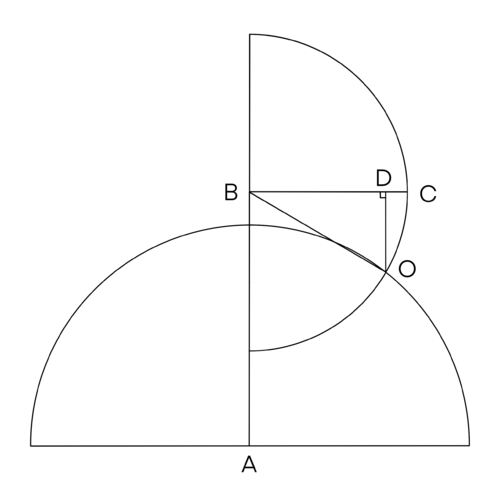Difference between revisions of "2003 AMC 12B Problems/Problem 21"
Math Kirby (talk | contribs) m |
(→Solution 3 (Geometric Probability)) |
||
| Line 44: | Line 44: | ||
~PeterDoesPhysics | ~PeterDoesPhysics | ||
| + | ==Solution 4 (Triangle Inequality)== | ||
| + | |||
| + | |||
| + | Note that we can treat <math>\text{ABC}</math> as a triangle with side lengths <math>5</math>, <math>8</math> and <math>AC=x.</math> Because <math>0</math> and <math>\pi</math> are not pat of the interval of valid <math>\alpha</math> values, <math>\triangle \text{ABC}</math> is a non-degenerate triangle. Then, by the Triangle Inequality, <math>5+8>x,</math> <math>5+x>8,</math> and <math>8+x>5.</math> These reduce to <math>x<13,</math> <math>x>3,</math> and <math>x>-3.</math> Thus, the possible values of x are <math>3<x<13,</math> or <math>x=\text{[}4,5,6,7,8,9,10,11,12\text{]}.</math> Of these <math>9</math> possible <math>x,</math> <math>3</math> of them are less than <math>7,</math> so the probability that <math>x<7</math> is <math>\frac39=\frac13=\boxed{\text{(D)}}.</math> | ||
| + | |||
| + | |||
| + | ~~AndrewZhong2012~~ | ||
== See also == | == See also == | ||
Revision as of 09:01, 8 August 2025
Contents
Problem
An object moves ![]() cm in a straight line from
cm in a straight line from ![]() to
to ![]() , turns at an angle
, turns at an angle ![]() , measured in radians and chosen at random from the interval
, measured in radians and chosen at random from the interval ![]() , and moves
, and moves ![]() cm in a straight line to
cm in a straight line to ![]() . What is the probability that
. What is the probability that ![]() ?
?
![]()
Solution 1 (Trigonometry)
By the Law of Cosines,

It follows that ![]() , and the probability is
, and the probability is ![]() .
.
Solution 2 (Analytic Geometry)
![]() , let the object turn clockwise.
, let the object turn clockwise.
Let ![]() ,
, ![]() .
.
Note that the possible points of ![]() create a semi-circle of radius
create a semi-circle of radius ![]() and center
and center ![]() . The area where
. The area where ![]() is enclosed by a circle of radius
is enclosed by a circle of radius ![]() and center
and center ![]() . The probability that
. The probability that ![]() is
is ![]() .
.
The function of ![]() is
is ![]() , the function of
, the function of ![]() is
is ![]() .
.
![]() is the point that satisfies the system of equations:
is the point that satisfies the system of equations: 
![]() ,
, ![]() ,
, ![]() ,
, ![]() ,
, ![]()
Note that ![]() is a
is a ![]() triangle, as
triangle, as ![]() ,
, ![]() ,
, ![]() . As a result
. As a result ![]() ,
, ![]() .
.
Therefore the probability that ![]() is
is ![]()
Solution 3 (Geometric Probability)
Setting ![]() we get that
we get that ![]() , after assuming segment AB to be straight in the x-direction relative to our coordinate system (in other words, due to symmetrically we can set
, after assuming segment AB to be straight in the x-direction relative to our coordinate system (in other words, due to symmetrically we can set ![]() for point B). This gives
for point B). This gives ![]() . Using the distance formula we get
. Using the distance formula we get ![]() . After algebra, this simplifies to
. After algebra, this simplifies to ![]() . After evaluating the constraints of the problem, we land on option (D).
. After evaluating the constraints of the problem, we land on option (D).
~PeterDoesPhysics
Solution 4 (Triangle Inequality)
Note that we can treat ![]() as a triangle with side lengths
as a triangle with side lengths ![]() ,
, ![]() and
and ![]() Because
Because ![]() and
and ![]() are not pat of the interval of valid
are not pat of the interval of valid ![]() values,
values, ![]() is a non-degenerate triangle. Then, by the Triangle Inequality,
is a non-degenerate triangle. Then, by the Triangle Inequality, ![]()
![]() and
and ![]() These reduce to
These reduce to ![]()
![]() and
and ![]() Thus, the possible values of x are
Thus, the possible values of x are ![]() or
or ![]() Of these
Of these ![]() possible
possible ![]()
![]() of them are less than
of them are less than ![]() so the probability that
so the probability that ![]() is
is ![]()
~~AndrewZhong2012~~
See also
| 2003 AMC 12B (Problems • Answer Key • Resources) | |
| Preceded by Problem 20 |
Followed by Problem 22 |
| 1 • 2 • 3 • 4 • 5 • 6 • 7 • 8 • 9 • 10 • 11 • 12 • 13 • 14 • 15 • 16 • 17 • 18 • 19 • 20 • 21 • 22 • 23 • 24 • 25 | |
| All AMC 12 Problems and Solutions | |
These problems are copyrighted © by the Mathematical Association of America, as part of the American Mathematics Competitions. ![]()










